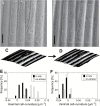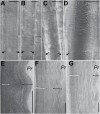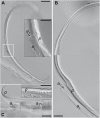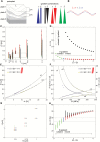Growing cell walls show a gradient of elastic strain across their layers
- PMID: 29945239
- PMCID: PMC6093493
- DOI: 10.1093/jxb/ery237
Growing cell walls show a gradient of elastic strain across their layers
Erratum in
-
Erratum: Growing cell walls show a gradient of elastic strain across their layers.J Exp Bot. 2018 Sep 14;69(20):4987. doi: 10.1093/jxb/ery280. J Exp Bot. 2018. PMID: 30107529 Free PMC article. No abstract available.
Abstract
The relatively thick primary walls of epidermal and collenchyma cells often form waviness on the surface that faces the protoplast when they are released from the tensile in-plane stress that operates in situ. This waviness is a manifestation of buckling that results from the heterogeneity of the elastic strain across the wall. In this study, this heterogeneity was confirmed by the spontaneous bending of isolated wall fragments that were initially flat. We combined the empirical data on the formation of waviness in growing cell walls with computations of the buckled wall shapes. We chose cylindrical-shaped organs with a high degree of longitudinal tissue stress because in such organs the surface deformation that accompanies the removal of the stress is strongly anisotropic and leads to the formation of waviness in which wrinkles on the inner wall surface are always transverse to the organ axis. The computations showed that the strain heterogeneity results from individual or overlaid gradients of pre-stress and stiffness across the wall. The computed wall shapes depend on the assumed wall thickness and mechanical gradients. Thus, a quantitative analysis of the wall waviness that forms after stress removal can be used to assess the mechanical heterogeneity of the cell wall.
Figures







Similar articles
-
Buckling of inner cell wall layers after manipulations to reduce tensile stress: observations and interpretations for stress transmission.Planta. 2005 Jan;220(3):465-73. doi: 10.1007/s00425-004-1353-z. Epub 2004 Sep 9. Planta. 2005. PMID: 15365835
-
The growing outer epidermal wall: design and physiological role of a composite structure.Ann Bot. 2008 Apr;101(5):615-21. doi: 10.1093/aob/mcn015. Epub 2008 Feb 7. Ann Bot. 2008. PMID: 18258808 Free PMC article.
-
Does growth correlate with turgor-induced elastic strain in stems? A re-evaluation of de Vries' classical experiments.Plant Physiol. 2001 Apr;125(4):2173-9. doi: 10.1104/pp.125.4.2173. Plant Physiol. 2001. PMID: 11299396 Free PMC article.
-
Collenchyma: a versatile mechanical tissue with dynamic cell walls.Ann Bot. 2012 Nov;110(6):1083-98. doi: 10.1093/aob/mcs186. Epub 2012 Aug 29. Ann Bot. 2012. PMID: 22933416 Free PMC article. Review.
-
Plant cell wall extensibility: connecting plant cell growth with cell wall structure, mechanics, and the action of wall-modifying enzymes.J Exp Bot. 2016 Jan;67(2):463-76. doi: 10.1093/jxb/erv511. Epub 2015 Nov 25. J Exp Bot. 2016. PMID: 26608646 Review.
Cited by
-
Whole-Tissue Three-Dimensional Imaging of Rice at Single-Cell Resolution.Int J Mol Sci. 2021 Dec 21;23(1):40. doi: 10.3390/ijms23010040. Int J Mol Sci. 2021. PMID: 35008463 Free PMC article.
-
Radial microfibril arrangements in wood cell walls.Planta. 2022 Sep 10;256(4):75. doi: 10.1007/s00425-022-03976-2. Planta. 2022. PMID: 36087126 Free PMC article.
-
The nonlinear mechanics of highly extensible plant epidermal cell walls.Proc Natl Acad Sci U S A. 2024 Jan 9;121(2):e2316396121. doi: 10.1073/pnas.2316396121. Epub 2024 Jan 2. Proc Natl Acad Sci U S A. 2024. PMID: 38165937 Free PMC article.
-
Mechanosensing, from forces to structures.Front Plant Sci. 2022 Dec 1;13:1060018. doi: 10.3389/fpls.2022.1060018. eCollection 2022. Front Plant Sci. 2022. PMID: 36531357 Free PMC article. Review.
-
Spatial consistency of cell growth direction during organ morphogenesis requires CELLULOSE SYNTHASE INTERACTIVE1.Cell Rep. 2023 Jul 25;42(7):112689. doi: 10.1016/j.celrep.2023.112689. Epub 2023 Jun 22. Cell Rep. 2023. PMID: 37352099 Free PMC article.
References
-
- Abasolo W, Eder M, Yamauchi K, et al. . 2009. Pectin may hinder the unfolding of xyloglucan chains during cell deformation: implications of the mechanical performance of Arabidopsis hypocotyls with pectin alterations. Molecular Plant 2, 990–999. - PubMed
-
- Bashline L, Lei L, Li S, Gu Y. 2014. Cell wall, cytoskeleton, and cell expansion in higher plants. Molecular Plant 7, 586–600. - PubMed
-
- Baskin TI, Jensen OE. 2013. On the role of stress anisotropy in the growth of stems. Journal of Experimental Botany 64, 4697–4707. - PubMed
Publication types
MeSH terms
LinkOut - more resources
Full Text Sources
Other Literature Sources

